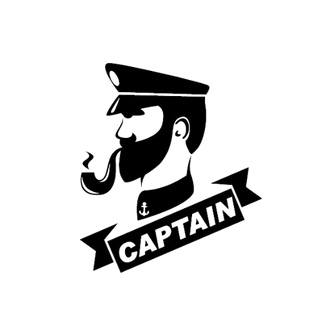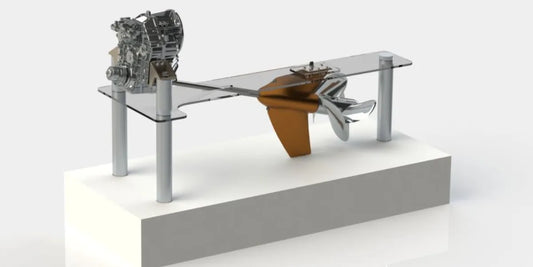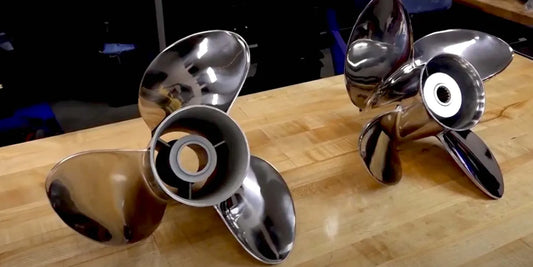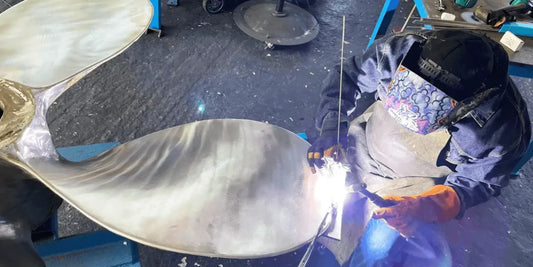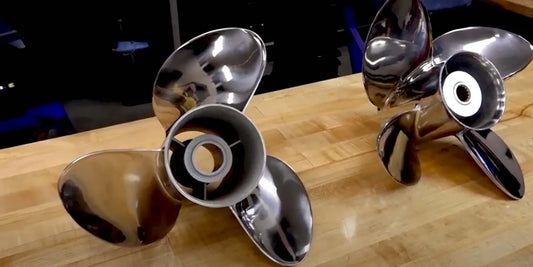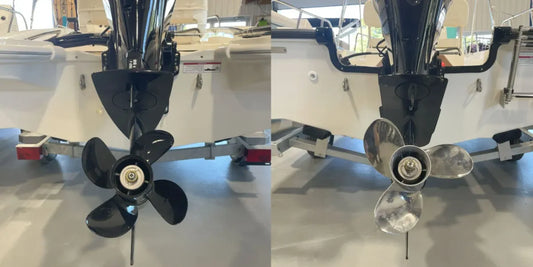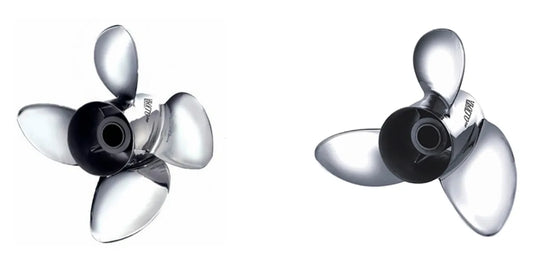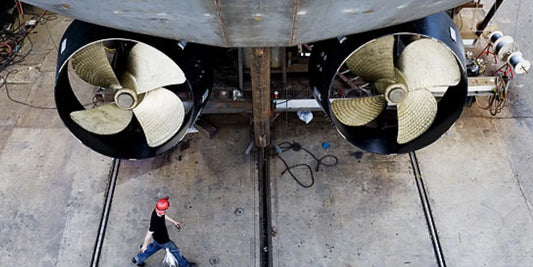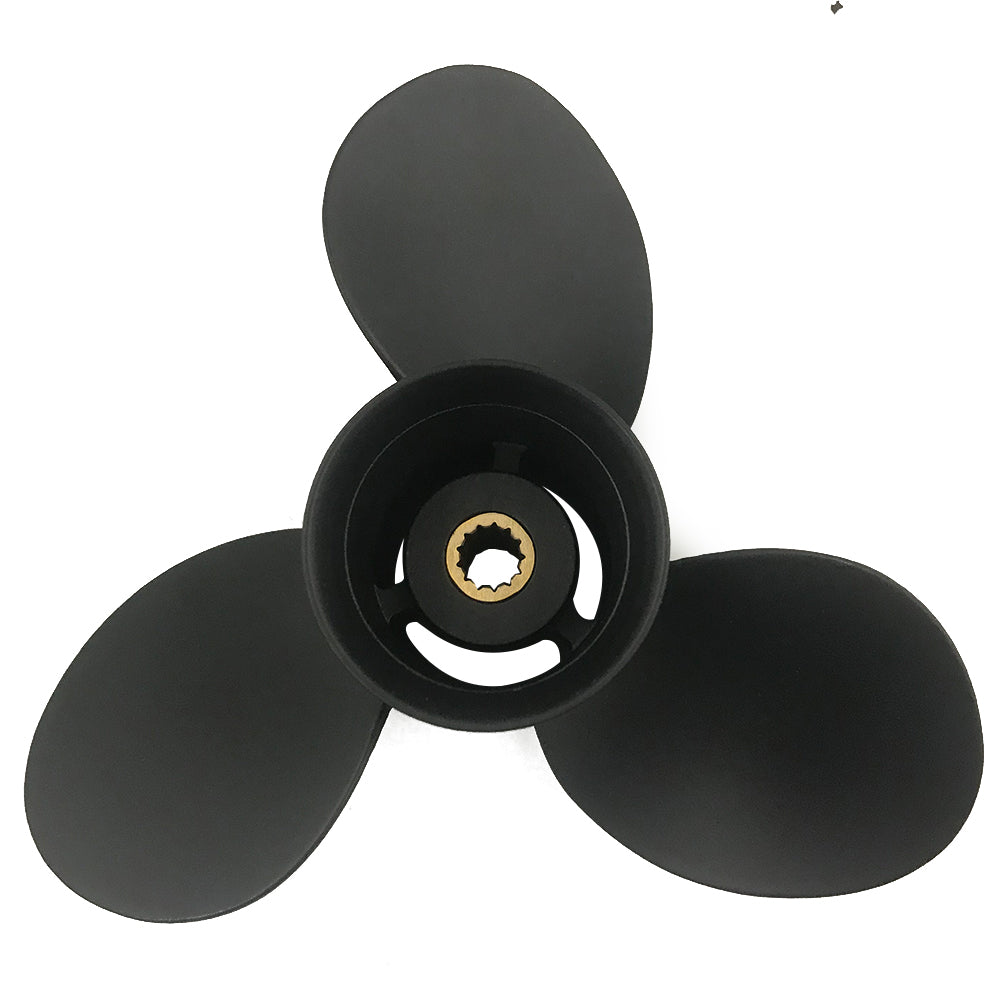In other words, in marine operations, propellers act as yachts to ensure smooth and efficient navigation on the surface of the water. Even the best propellers lose their efficiency when they are not maintained and have to be subjected to an expensive cost of repair, along with potential downtime. This blog post will outline common maintenance tips to keep yacht propellers in good condition, extend their working life, and prevent potential issues before they arise. The insights shared here will benefit both seasoned yacht owners and newcomers to the world of yachting as they work toward optimizing their vessel's performance and embarking on worry-free adventures on the high seas.
Understanding Yacht Propellers

Types of Boat Propellers
Boat propellers come in various types, each designed to perform differently according to the needs and characteristics of the vessel. Major types include fixed-pitch propellers, controllable-pitch propellers, and surface-piercing propellers.
Fixed Pitch Propellers (FPP): It is the most common type of propeller used in yachts. The blades are set at a fixed angle, providing simplicity and strength in construction. These propellers are typically made from bronze or stainless steel, are thick, and are resistant to wear and tear. They are suitable for general work. They require no additional adjustments and deliver a reliable performance.
Controllable Pitch Propellers (CPP): The pitch can be changed while the propeller is still rotating. This feature enhances maneuvering capabilities, improves fuel efficiency, and facilitates adaptation to varying load conditions. Such requirements exist in vessels that frequently change speed and direction, such as ferries or larger yachts equipped with advanced control systems.
Surface-Piercing Propellers (SPP): These propellers are partially submerged, thanks mainly to the acts of the higher-speed vessels. They are intended to reduce drag and enhance efficiency at high speeds, thereby maximizing performance for racing boats or performance-oriented yachts. Nonetheless, they must be correctly designed and operated.
Feathering and Folding Propellers: Used primarily on sailboats, these propellers reduce drag while the yacht is sailing at leisure. In a feathering propeller, the blades align with the flow of the water, while folding types shut inward. Both types improve sailing potential but can still be used for propulsion when needed.
Each propeller type carries the specifics as prototype and design of the yacht itself, duly concerning its function and performance expectations. Matching the propeller type to your vessel will ensure enhanced fuel economy, reduced engine wear, and a more comfortable boating experience.
Benefits of Stainless Steel Over Aluminum Propellers
Among the common materials used in propeller manufacturing are stainless steel and aluminum, each affording different benefits based on vessel requirements. Stainless steel propellers, on the other hand, have superior durability, strength, and resistance to damage from debris or impacts, exceeding aluminum ones in almost every respect. Acceptance of more shape deformation from high stress levels, which lessens long-term performance and efficiency, also has limitations when casting aluminum. Another advantage of the stainless steel propeller is its ability to accommodate more complex blade geometries, which can increase acceleration and top speed.
Meanwhile, aluminum propellers are significantly lighter and less expensive than stainless steel propellers, making them suitable for ordinary recreational boating activities. Aluminum propellers offer the added advantage of ease of repair and moderate replacement costs. This would be particularly helpful for the casual boater or the operator in shallow water, where propellers are more prone to damage. However, this kind of propeller would usually be less durable than stainless steel under conditions of frequent or high stress.
Factors such as type, environment, and budget should significantly influence one's decision between stainless steel and aluminum. Stainless steel will build great long-term value for performance-based applications, while aluminum remains a cost-effective and practical choice for general use.
Roles played by Acme and Volvo Penta in propeller design
Acme and Volvo Penta indeed played vital roles in advances in propeller technology, marrying innovative engineering with precision manufacturing to serve various marine needs. Acme is famous for its CNC-machined perfection-propellers whose performance and reliability remain invariable. Their designs tend to minimize vibration and promote acceleration and fuel economy, making them highly sought after by recreational boaters and the watersports crowd.
On the contrary, Volvo Penta stands at the forefront when it comes to integrated marine propulsion solutions, offering a propeller that is utterly designed to match their propulsion system. Thus, the propeller stands essentially for strength and hydrodynamics and hence excels under various load conditions. Double prop systems are well-known for providing better grip, stability, and maneuverability. Both Acme and Volvo Penta continue to revolutionize propeller design, embracing a balance of performance and utility for the benefit of various marine applications.
Regular Maintenance Practices for Boat Props

Inspection Tips For Inboard and Outboard Propellers
Regular inspection of both inboard and outboard propellers is crucial to ensure optimal performance and prevent unexpected issues from developing during use. For inboard propellers, look for any apparent damage: bends, cracks, or nicks along the edges. Usually, a small deformation of the propeller is enough to disturb its functioning and thus reduce its efficiency. Shaft alignment is equally important, as any misalignment will cause vibrations and increased wear on the surrounding components. The keyway and nut must also be inspected to ensure that they are secure and show no signs of corrosion.
Remove the propeller first, then check the hub and splines for wear or damage. Debris, such as fishing lines or weeds, might wrap around the propeller shaft and damage the seals; therefore, cleaning this area thoroughly should be part of every inspection. Be suspicious of cavitation erosion on blade faces and confirm that all blades remain uniform in shape, free of cracks, and without deformation. Also, check for any looseness or free play in the attachment of the prop so that, during operation, it remains firmly held in place. Frequent cleaning and lubrication of the moving parts help smooth operation and extend propeller life.
Cleansing and protecting your marine propeller is essential
Proper cleaning and protection methods are essential for the longer life and better functionality of your marine propeller. Rinse your prop thoroughly after each use with fresh water to remove salt, dirt, or other debris that may have accumulated during operation. Since saltwater contributes significantly to corrosion, rinsing becomes crucial in preventing long-term damage. Use a soft brush and gentle cleaner to scrub off grime, ensuring you clean all edge spaces.
Marine antifouling paints or coatings provide an additional layer of protection against corrosion and marine growth. Applications of these coatings act as barriers against barnacle or algae build-up. The idea is to make cleaning easier in the long run. Inspect seals, grease the fittings, and re-lubricate any moving parts with water-repellent grease to maintain them in optimal condition for sculpting. Such maintenance should be integrated to protect your investment and ensure your propeller will provide reliable and efficient performance.
Identification of Wear and Damage Signs
The importance of performing regular inspection of the propeller cannot be overstated, as it is one of the maintenance procedures that help catch early signs of wear so that the damage does not progress any further. Check for any obvious issues, such as cracks, chips, or bends on the blades, as these could be detrimental to performance and fuel efficiency. More wear signs would be vibration in operation: A bit of imbalance in the blades, or some slight damage may cause one. Corrosion is usually visible as discoloration or pitting and can affect the structural integrity of the propeller, particularly in saltwater environments. A heavy accumulation of marine growth or debris around the blades can cause imbalances or reduce thrust. Changes in engine performance, such as difficulty reaching the target RPM, can also be a propeller issue. In this way, a good maintenance regime with checks and prompt responses to warning signs will keep the equipment running at its best and prolong its life.
Advanced Maintenance Techniques

Balancing and Tuning Your Boat Propeller
Balancing and tuning your boat propeller is the next step in maximizing its performance and efficiency. A correctly balanced propeller will reduce vibrations, increase fuel efficiency, and lessen stress on the engine and other mechanical elements. To balance the propeller, inspect for any dents, cracks, or uneven wear, as these factors can prevent symmetry. Using professional equipment, such as a propeller balancer, one can determine the location of the imbalance and remove material or make suitable adjustments until equilibrium is restored.
Tuning involves adapting the pitch or blade shape for specific operating conditions, which may include heavy loads and varying water depths. For example, a higher pitch will help increase speed on light loads, whereas a lower pitch can help build acceleration for heavy cargo. The use of modern materials, such as stainless steel, in tuning is well-deserved, as they resist deformation and wear better. It is also essential to follow the manufacturer’s directions and not over-tune, as this might compromise the vessel's safety or performance. A propeller that is well-balanced and fine-tuned through regular maintenance will permit smoother navigation and provide a longer life span to your boating equipment.
When to Replace vs. Repair Your Propeller
Depending on the extent of the damage and the general condition of the component, one considers whether a propeller should be repaired or replaced. Minor imperfections, such as small dents, slight bends, or scratches, can commonly be adequately fixed by professional repair, and thus, the expenses are less than replacing the entire item. However, greater damages, such as large cracks, broken blades, or irreparable corrosion, would generally warrant replacing the propeller for safety and performance reasons. Maintenance aids in observing wear and tear early, thus avoiding sudden failures in operation. Furthermore, the material of your propeller must be taken into consideration; aluminum versions may require slight repairs but are prone to fatigue over time, while stainless steel propellers offer greater longevity but may prove more expensive to replace. When evaluating repair versus replacement, you always have the propeller's age, its impact on performance, and the potential long-term costs associated with each alternative in the back of your mind.
Tools and Equipment Selection for Prop Maintenance
Choosing the right equipment to keep a propeller installation operating efficiently and safely. Begin by securing the basic tools: a prop wrench, a device to safely remove and attach the prop nuts without anyone getting hurt. A torque wrench comes in close second, as it is used to re-install the propeller nut to the correct torque setting; if over-tightened, it may not operate correctly and may even become loose during operation. For cleaning, a soft-bristle brush coupled with marine cleaning chemicals will be an effective combination for removing debris, algae, and salt build-up. If there is polishing to be done, then a good metal polish for the material of your propeller will do; it could be aluminum or stainless steel.
A few specialized tools are included in the toolkit for more advanced repairs, such as blade straighteners or pitch gauges, which can be used for minor blade straightening or balancing. Then again, be an expert in your technique, as incorrect use can worsen existing damage. Moreover, to ensure a safe working environment, protective equipment, such as gloves and safety goggles, must also be worn. Having a good set of non-corrosive-quality tools will help maintenance procedures become not only practical but also durable, providing a long-term solution for prop maintenance.
Performance Optimization for Boat Propellers

How Propeller Pitch Determines Boat Efficiency
The relationship between the pitch of a propeller and the efficiency of a motorboat has consequences for performance. The propeller pitch theoretically describes the distance an imaginary line moves forward during one complete rotation of the propeller, assuming no slip. Thus, a higher-pitch propeller will theoretically move a greater distance in one rotation, so there would be more speed theoretically available with the available engine power to maintain proper operation on the boat. A low-pitch propeller, however, could give good acceleration and power at low speeds, which might be required for towing purposes or in rough waters.
The choice of an appropriate propeller pitch depends on the vessel's weight, hull design, and other factors related to the boat's intended use. For instance, a lightweight powerboat seeking to achieve high speed on calm waters may opt for a high-pitch propeller, whereas a fishing boat operating in varying conditions could excel in handling and fuel economy with a low-pitch one. According to the literature, if the pitch is not matched to the RPM range recommended by the engine manufacturer, the engine may be strained, fuel may be wasted, or it may not perform at the optimal power level. Hence, determining the correct pitch is a balancing decision that becomes a factor in maximizing overall boat performance, fuel economy, and engine life in the long run.
The effect of prop size on speed and fuel consumption
Directly, propeller size determines the speed at which a particular boat can move and its fuel consumption. Larger diameter props push more water; this thrust and torque, provided by the movement of water by a larger prop, may go well with heavier boats or towing. Conversely, they also load the engine; thus, if these props are not suitable for the ship, their maximum speed and fuel efficiency may be impaired.
In the case of small-diameter propellers, they are generally capable of allowing higher RPMs, which enables faster speeds for light boats or boats designed for quickness. However, these small-diameter propellers rarely have the thrust to pull heavier loads. Hence, the engine is overcharged, resulting in inefficient operation and higher fuel consumption. The crush and blade shape, in turn, work in conjunction with the propeller diameter to determine these effects, thereby emphasizing the need for a dedicated solution that accommodates all operating conditions.
All studies and manufacturers' data indicate that fuel efficiency can be increased by optimizing engine performance through the proper selection of propeller size. Attention must be given to appropriate sizing so that periodic checks and adjustments can be made, allowing the boat to run at its highest efficiency and saving engine wear and tear.
Upgrade Your Propeller for Maximum Performance
Upgrading the propeller yields significant performance improvements for the boat, particularly in terms of fuel efficiency and other handling qualities. In choosing an upgrade, the key considerations to examine include the material, pitch, diameter, and blade count. The materials commonly used are aluminum and stainless steel, with the latter possessing greater durability and performance qualities but being more expensive. The pitch and diameter affect speed and power. From experience, top speeds are achieved by using propellers with a higher pitch, while acceleration and responsiveness are higher with propellers of lower pitch.
Blade numbers also play a critical role in affecting performances. With fewer blades, there is less drag and thereby higher speed; more blades give smoother operations and greater balance, especially in rough waters. Armed with such an understanding of these parameters about your engine specifications and the intended application, you will be able to select a propeller that best suits your needs. Using professional judgment and regular maintenance will keep the upgraded propeller performing well over time.
Safety Considerations for Yacht Propeller Maintenance

Best Practices for Providing Safe Handling to Propellers
When it comes to the safe handling of the propeller, I always follow precautions to safeguard myself and the vessel. Upon approaching the propeller, I set everything off, including the engine's keys. Even the slightest start-up could have dire consequences if someone's fingers are around the propeller. I also wear a pair of gloves on my hands to protect against sharp edges or garbage that may be lying on the propeller. Personal safety is my utmost concern, so I work on a stable surface that is unlikely to result in any slip or mishandling of the tools.
Having learned to inspect the propeller for any indications of damage or wear during maintenance, I address any such issues that arise. I do not hesitate to intervene if I detect slight dents or cracks in the blades or if I notice barnacle buildup, as this could lead to more serious problems in the future. The proper equipment needs to be used so that the propeller can be pulled without damaging either myself or my gear; for instance, a good propeller puller is always the right choice. From a safety perspective, solo work should be avoided whenever possible, as an extra set of hands serves as a valuable backup in case of an emergency or if assistance is truly needed.
Lastly, I remain aware of the environmental effects of working on propellers. I always dispose of any old parts or damaged propellers responsibly, and I never allow lubricants or other chemicals to enter the water. Such actions keep me safe and maintain the operational integrity of my yacht, while also respecting marine ecosystems. Regular incorporation of best practices makes the maintenance work safer and increases the performance and reliability of my vessel in the long run.
What About the Risks of Improper Maintenance?
If my yacht is subjected to improper or inadequate maintenance, it can pose serious risks to both the vessel and the environment. For example, a mechanical issue that occurs due to inadequate maintenance, such as engine failure or propeller problems, can cause a delay in repairing the yacht. In some cases, the repair may even be more expensive, rendering the yacht unusable. At some point, greater chances of wear and tear upon vital machinery like hull construction and electrical work, which gradually occurs if it is not given priority, which then poses safety issues when engaging in water.
Moreover, if the yacht is not kept clean and inspected regularly, corrosion will set in through chemical action, while marine growth builds on the hull, impacting both the performance and lifespan of the yacht.
Another significant aspect is the environmental risk associated with such poor maintenance. I could pollute the waterways and marine ecosystems if I let oil leaks pass by, in blatant pollution of the vessel, or if I do not handle the waste properly. Fuel or lubricant contamination entering a water body will harm aquatic life and jeopardize fragile ecosystems. Not inspecting the cooling systems or exhaust systems also results in their emissions increasing, contributing to environmental degradation.
To mitigate these risks, I adhere to a stringent maintenance schedule that follows best practices and manufacturer regulations. It ensures that my yacht operates efficiently and safely, while helping me contribute my part toward environmental conservation and marine conservation efforts. Regular upkeep that respects all the technical considerations is something I value highly, for the sake of my comprehension of the vessel's wellbeing, and hence, the protection of the water bodies surrounding it.
Emergency Procedure in the Case of Propeller Incidents
Safety is always the priority in the event of an emergency with the propeller; I follow a set procedure for the immediate application and resolution of the problem. At the first suspicion of a propeller issue, speed reduction ensues as an assessment of the seriousness of the matter is carried out. It is of utmost importance that the safety of the passengers is observed and ensured, while at the same time, the engine must not be strained further. Another vital thing to remember is to cut off the engine if the vessel has to come to a complete stop, to prevent further damage to the propeller and to ensure the safety of persons in the water.
Once everyone has been secured in immediate safety, I have to determine what exactly the problem is, whether it is debris wrapped around the propeller or a mechanical failure. I have to either use a boathook or, if it is safe, reach the propeller and clear away the debris or assess the malfunction. If resolving the problem cannot be performed on my own, I would ask for help from nearby vessels or marine rescue services through my onboard communication or an emergency radio.
Lastly, after the situation is resolved, I will document the incident and conduct a thorough inspection of my vessel. Learning from situations like these will help prevent their recurrence, which is why I always strive to improve my preparedness for emergencies by keeping all necessary equipment on board and ready for use. It is through these acts that the lives of my passengers and my vessel are saved, which is what I believe to be the hallmarks of responsible seamanship.
Reference Sources
- Propeller Maintenance - Boat Maintenance Tips
- 7 Tips for Boat Propeller Maintenance
- A Must-Know Guide to Boat Propeller Maintenance
- Propeller Maintenance Guide by Yamaha Outboards
- The Essentials Of Boat Propeller Repair
Frequently Asked Questions (FAQs)
How are stainless steel propellers beneficial for my boat?
Stainless steel propellers are much more durable and stronger than aluminum ones. In fact, they are corrosion-resistant; thus, they are best suited for use in marine atmospheres. Acceleration and top speed may be improved with stainless steel propellers owing to their rigidity and design. The boat-taking experience can really be improved. Generally, stainless steel propellers last longer, making them a better economic option for boat owners in the long term. Hence, investing in a high-quality stainless steel propeller may make a noticeable difference in fuel consumption and improve performance.
How is one to select a propeller given the propulsion system of their yacht?
The choice of a propeller is influenced by several factors, including the size and weight of the yacht, engine capacity, and intended usage. Good stopping power and acceleration are achieved through different configurations of 3-blade and four-blade stainless steel. These are the few things a person has to analyze while selecting the propeller: your actual boating needs-watersports, cruising, etc.-to be in harmony with the design of your yacht. If you hire an expert in the marine industry to accompany you through the maze-like technicalities of the propeller, he will end up steering you in the direction best suited for the right hub system for your shaft. Consider RPMs and fuel consumption efficiency as key factors in your decision.
What are the differences between aluminum and stainless steel propellers?
Lightweight and cost-effective, aluminum propellers are a favorite among recreational boaters. However, the ability to perform and withstand hard use is not always detracted by aluminum propellers. Stainless steel propellers are designed for more serious applications and offer some of the best protection against damage and corrosion. They do provide better water pumping at high speeds and increase the efficiency of the boat upon which they are fitted. Therefore, for lighter requirements, aluminum has been the preferred choice of DIY boat enthusiasts. At the same time, stainless steel is usually preferred by those with a serious boat who want maximum propulsion and reliability. The final decision depends on the nature of your use and your expectations for the yacht's performance.
How does cavitation affect the performance of a yacht's propeller?
When the pressure on the propeller blade drops below water vapor pressure, air bubbles begin to form. This phenomenon could adversely affect the propulsion of your yacht and its overall performance. Vibration, thrust loss, and propeller damage over time are such effects of cavitation. High-speed propellers will minimize cavitation with the said blade configuration and material. Rocking motion could go a long way in reducing cavitation if your propeller is perfectly matched to your engine and the speed of your boat. Maintenance should always be carried out so that, along with checking the hub kit and bearings, your propeller's performance remains at its best, thus preventing problems related to cavitation.
So what are the benefits of using a 4-blade stainless steel prop?
Beyond the shorelines of recreation, aquatic adventures span possibilities for every watersport. A four-blade propeller tends to gain recognition for increased grip and maneuvering ability. The extra blade means added surface area for propulsion and acceleration out of the hole. This translates well into acceleration and glide in rough water. Additionally, a 4-blade configuration provides relief from cavitation and improved ventilation, resulting in better fuel economy. Although stainless steel props offer an acceptable option for golfers seeking to achieve maximum playing performance while ensuring durability, the design process may sometimes utilize advanced CNC technology to achieve precision and quality.
What are the factors to consider while replacing a yacht propeller?
When changing a yacht's propeller, several key aspects should be taken into consideration to ensure smooth performance. First, it is necessary to assess the existing propeller for the type of material used and whether it is a 3 or 4-blade stainless steel or aluminium construction. Understanding the exact performance requirement of your yacht and its usage will help you select the appropriate replacement. Also, check for hub designs and their compatibility with your existing setup, including the type of shaft. Consider also the engine's intended RPM range, acceleration, and how these factors impact maneuverability. Any professional opinion will help in decision-making to achieve maximum performance from the new propeller.
